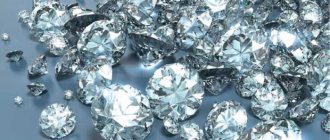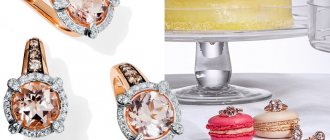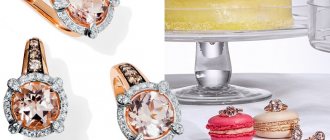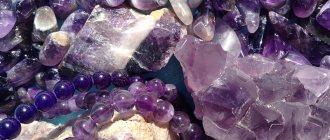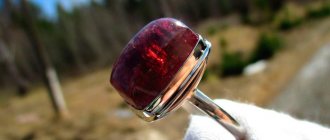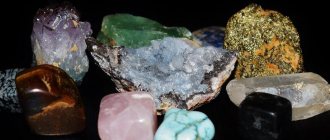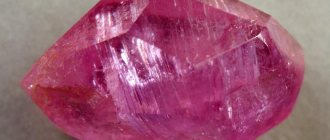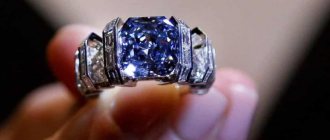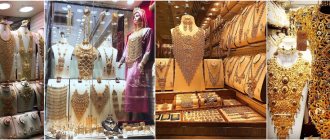Treated and untreated gemstones.
Before defining what artificial (synthetic) minerals are, you must first understand what factors allow them to be considered natural (genuine).
Natural gemstones, as the definition suggests, are minerals that occur in nature.
They are not refined (processed to improve color and clarity), the only acceptable “amendment” is cutting of different types.
Treated are natural gemstones that have undergone some processing to improve their appearance.
Since natural crystals are not always perfect in their original purity and color, these characteristics can be improved by treatment with heat, chemicals, ionizing radiation, or laser.
The name “refined gemstones” is used to distinguish natural treated crystals from those that have not been treated.
Well-known production centers
More than a hundred tons of artificial sapphires are produced annually in the world. Centers for the production of synthetic stones: Japan, China, USA, and Russia. It is in the Russian Federation that one of the largest enterprises for growing artificial sapphires in the world is located.
One of the largest enterprises specializing in the production of emerald analogues is Tairus. It was created by forces of Russia and Thailand. The specialists of this center managed to grow emeralds whose quality is in no way lower than the world-recognized Colombian gems. Emeralds are also grown in Japan and Belarus. Among European countries, Switzerland, Germany and France specialize in green stones.
Most artificial pearls are grown in China and Japan.
Natural minerals will always be in demand and will never fall in price. Especially considering that stocks are constantly decreasing. In many cases, they can be replaced by artificial analogues. Synthetic stone can be grown in any color, large size and with specified technical characteristics.
What are artificial and synthetic gemstones, is there a difference between them?
Artificial gemstones are crystals made in a laboratory. They are obtained by high pressure processing of the same components as in natural minerals.
That is why synthetic gemstones are absolutely identical to their natural “colleagues” in their chemical composition and physical properties.
Stones created in a laboratory often have very high purity. If the stone you are looking at seems too clear and perfect, it may be synthetic.
Price may also give you a clue, since synthetics tend to be cheaper.
Therefore, when in doubt, always ask if the stone is genuine. After all, you don’t want to buy a fake for the price of a real gem.
These terms are often used in the jewelry trade. Although both are used interchangeably, some sellers use the term "synthetic" to classify counterfeit gemstones.
However, artificial gemstones can in no way be considered fake, since it has already been mentioned that they are absolutely identical to natural ones in all respects.
They differ only in the way they are obtained: natural ones are a product of the earth’s bowels, and created ones are a product of human labor and intelligence.
On the other hand, fake crystals are simply imitations of certain types of precious minerals, made from various cheaper minerals and materials.
If you are convinced that a gemstone on offer is a synthetic product, you should always verify its origin and composition to ensure the correct classification of the mineral.
Moissanite
Here is the highest quality and most expensive diamond substitute on the modern market. But here there is a confusion of concepts. Moissanite is a mineral of natural (most likely cosmic) origin. Its crystals are extremely small and are not used in the jewelry industry.
But the artificial analogue of moissanite, carborundum, is much more widespread. It is used as inserts in jewelry. Carborundum approaches diamond in hardness (9.5 on the Mohs scale) and is significantly superior to it in its ability to withstand heat. It sparkles even brighter than a diamond!
Imitation and counterfeiting of minerals.
Fake and synthetic gemstones are two different things. When purchasing, you need to be wary of purchasing a fake stone that is advertised as a synthetic product.
Imitation gemstones are exactly what is meant by the term fake or counterfeit.
They are made from materials that only resemble a certain type of mineral in appearance, but in fact are not at all similar to it, i.e. have different chemical and physical properties.
Of course, fake gems are cheap, and are usually made from glass, some types of plastic or ceramics. They are less reliable than natural and synthetic crystals, which means it is much easier for them to suffer irreparable damage, and cost tens and hundreds of times less than natural stone, respectively.
Attention! Counterfeit and synthetic gemstones are two different things, and when purchasing, you need to be very careful not to buy a fake under the guise of a synthetic product.
Rutile
Rutile is one of the cheapest and lowest quality diamond analogues. Chemically, it is titanium oxide; physically, it is a natural cloudy brown crystal. It is of little use for jewelry purposes.
However, in the middle of the last century, they learned to make rutile artificially, giving it the appearance of a diamond. At that time, this was a breakthrough in the jewelry industry, and jewelry with “titanium” or “rainbow stone” filled store shelves. But artificial rutile is quite soft and prone to clouding.
Steel earrings in gift packaging with Swarovski crystals (go to the SUNLIGHT catalog)
Why buy artificial crystals?
If there are so many different beautiful natural gems, then why is it necessary to create artificial minerals?
The problem is that a huge number of natural ones do not fully have the qualities preferred by potential buyers.
For example, they have quite a lot of flaws that detract from their natural beauty, and the color is often dull.
This does not mean that natural high-quality gems do not exist. They are just rare and very expensive.
That is why synthetic minerals were created - similar in their properties to natural ones, just as durable, but cheaper and more accessible.
Another reason to prefer artificial gems: when creating them, you can avoid many disadvantages and at the same time achieve almost perfect purity quite easily.
Comparing a created gemstone with a typical natural one, one can notice that a natural one will always have a certain (albeit very minimal) amount of inclusions in the form of black dots or cloudy spots.
If you decide to buy an artificial crystal, then make sure that you are purchasing it from a reputable jeweler (or brand company), and do not forget to ask for a certificate of origin.
Keep in mind that not all lab-grown crystals are of the same quality and price - they also have a fairly flexible gradation of these characteristics. But remember that a high-quality synthetic product will never cost as much as a top-quality natural one.
To make the final decision, be sure to once again make sure that you are really satisfied with the quality and appearance of the selected artificial gemstone, and - a successful purchase!
Should you always choose higher purity?
You may already know that clarity is one of the four elements that determine the quality of a diamond, but what about other gemstones? You of course want to make sure that their color is what you are looking for, but you should also look at the clarity and how?
Assessing the purity of a gemstone.
Like diamonds, other stones are also classified based on clarity. And the classification principle is the same: the fewer inclusions, the higher it is. However, they are not rated on a generally accepted scale.
Different jewelers use different methods, but the general concept of all these scales is the same.
You, as the client, should be concerned with how many inclusions the stone has and how visible they are, right?
In fact, with colored stones it is not so simple.
Where are synthetic diamonds used?
As mentioned above, an artificial diamond differs from a real one only in origin: from all other points of view, these minerals are identical. This means that the scope of application of artificial diamonds is exactly the same as that of natural stone.
The vast majority of artificial diamonds are manufactured specifically for technical needs. They are used in the production of cutting tools and abrasives, electronics and optical instruments, medical equipment and drilling rigs.
Gold ring with diamonds (go to the SUNLIGHT catalogue)
The best specimens, distinguished by their purity and large enough size, are turned into diamonds and adorned with rings, bracelets, pendants, earrings, brooches and other jewelry.
Why might low purity be a good sign?
The relationship between clarity and quality in gems is not as direct as in diamonds, where the fewer inclusions, the better they sparkle.
However, colorless diamonds are preferred while most other gemstones are purchased for their color.
And the most interesting thing is that gems get their color from various chemical elements in their structure, which are considered as inclusions.
Thus, it turns out that inclusions that reduce the clarity of gemstones also give them their color. If you want an intensely colored stone, it will likely have more inclusions.
The relationship between clarity and color varies among different gemstones, which is why you must decide on a case-by-case basis whether you like the way a stone looks or not.
Introduction
Natural materials - wood, clay and, of course, stone - have firmly established themselves in home decoration long before the concept of interior design appeared. And if earlier the choice was determined by such material qualities as strength and durability, now visual characteristics are on a par with them.
Decorating walls and floors with decorative stone
A wide choice of colors, textures and formats makes decorative stone one of the most popular materials in interior and exterior decoration. The floor, walls or figured masonry of the fireplace made of natural and artificial stone add a touch of luxury to the room, emphasizing the style and individuality of the interior of an apartment or private house.
To determine which type of stone is right for you, you need to understand the range and qualities of a particular material. So what kind of stone is used in interior decoration?
What to look for when purchasing?
The exact criteria for judging gems depends on their type, but there are some general tips that apply to everyone.
First, make sure you like the color and transparency. Keep in mind that the larger the stone, the more inclusions will be visible when worn.
After this, take a closer look at the stone to see any signs of damage on its surface or interior.
Make sure it is not broken as any chips will weaken its structure.
In addition, there should not be any cracks in it. Any damage to the structural integrity may cause the stone to break upon impact.
Rhinestones
This group includes a variety of imitations of diamonds created on the basis of glass. It is difficult to confuse an ordinary piece of glass with a noble stone, but jeweler Georg Strass managed to get closer to the ideal, at least visually. He developed a technology for applying metal powder to the glass surface, which made it possible to obtain a spectacular “diamond” shine.
The price of rhinestones varies widely: from a penny for Chinese-made trinkets to very expensive ones for the famous Swarovski crystals. However, the highest quality rhinestone is not even close to a diamond, and it scratches almost like ordinary glass.
Swarovski rhinestones have a unique composition, which is why they are so highly valued in the world. More than a century ago, the maestro developed a technology for the production of artificial crystal, which to this day remains secret and unsurpassed.

